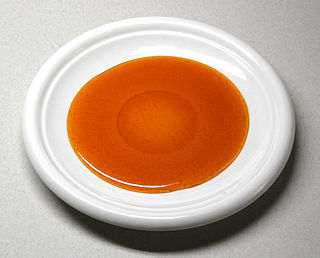
Caramel is an orange-brown confectionery product made by heating a range of sugars. It can be used as a flavoring in puddings and desserts, as a filling in bonbons or candy bars, or as a topping for ice cream and custard.
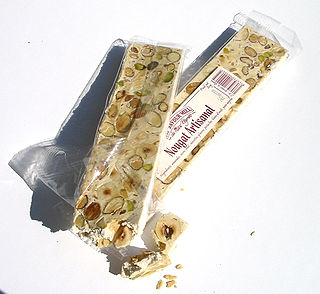
Nougat is a family of confections made with sugar or honey, roasted nuts, whipped egg whites, and sometimes chopped candied fruit. The consistency of nougat is chewy, and it is used in a variety of candy bars and chocolates. The word nougat comes from Occitan pan nogat, seemingly from Latin panis nucatus 'nut bread'.
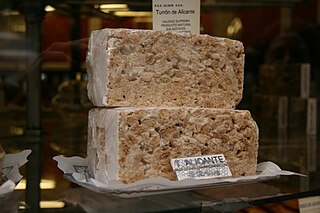
Turrón, torró or torrone is a southwest European and Moroccan nougat confection, typically made of honey, sugar, and egg white, with toasted almonds or other nuts, and usually shaped either into a rectangular tablet or a round cake. Turrón is usually eaten as a dessert food around Christmas in Spain and Italy. It is also popular in Portugal, Morocco, and Latin America.
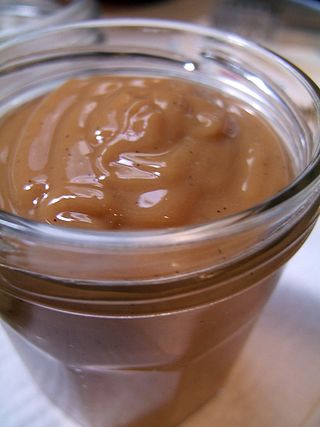
Dulce de leche, caramelized milk, manjar, milk candy or milk jam is a confection popular in Latin America, France, Poland and the Philippines prepared by slowly heating sugar and milk over a period of several hours. The resulting substance, which takes on a spreadable, sauce-like consistency, derives its rich flavour and colour from non-enzymatic browning. It is typically used to top or fill other sweet foods.

A Swiss roll, jelly roll, roll cake, cream roll, roulade or Swiss log is a type of rolled sponge cake filled with whipped cream, jam, icing, or any type of filling. The origins of the term are unclear; in spite of the name "Swiss roll", the cake is believed to have originated elsewhere in Central Europe, possibly Austria or Slovenia. It appears to have been invented in the nineteenth century, along with Battenberg cake, doughnuts, and Victoria sponge. In the U.S., commercial snack-sized versions of the cake are sold with the brand names Ho Hos, Yodels, Swiss Cake Rolls, and others. A type of roll cake called Yule log is traditionally served at Christmas.

Filipino cuisine is composed of the cuisines of more than a hundred distinct ethnolinguistic groups found throughout the Philippine archipelago. A majority of mainstream Filipino dishes that compose Filipino cuisine are from the food traditions of various ethnolinguistic groups and tribes of the archipelago, including the Ilocano, Pangasinan, Kapampangan, Tagalog, Bicolano, Visayan, Chavacano, and Maranao ethnolinguistic groups. The dishes associated with these groups evolved over the centuries from a largely indigenous base shared with maritime Southeast Asia with varied influences from Chinese, Spanish, and American cuisines, in line with the major waves of influence that had enriched the cultures of the archipelago, and adapted using indigenous ingredients to meet local preferences.

Halo-halo, also spelled haluhalo, Tagalog for "mixed", is a popular cold dessert in the Philippines made up of crushed ice, evaporated milk or coconut milk, and various ingredients including side dishes such as ube jam, sweetened kidney beans or garbanzo beans, coconut strips, sago, gulaman (agar), pinipig, boiled taro or soft yams in cubes, flan, slices or portions of fruit preserves and other root crop preserves. The dessert is topped with a scoop of ube ice cream. It is usually prepared in a tall clear glass and served with a long spoon. Halo-halo is considered to be the unofficial national dessert of the Philippines.

Kalamay is a sticky sweet delicacy that is popular in many regions of the Philippines. It is made of coconut milk, brown sugar, and ground glutinous rice. It can also be flavored with margarine, peanut butter, or vanilla. Kalamay can be eaten alone; but is usually used as a sweetener for a number of Filipino desserts and beverages. It is related to the Chamorro dessert called Kalamai.

Puto is a Filipino steamed rice cake, traditionally made from slightly fermented rice dough (galapong). It is eaten as is or as an accompaniment to a number of savoury dishes. Puto is also an umbrella term for various kinds of indigenous steamed cakes, including those made without rice. It is a sub-type of kakanin.

Krówki, literally meaning "little cows," are Polish fudge, semi-soft milk toffee candies. When hand-made, they are hard and crispy on the outside, but the inside is more fluid than solid.

A polvorón is a type of heavy, soft, and very crumbly Spanish shortbread made of flour, sugar, milk, and nuts. They are mostly produced in Andalusia, where there are about 70 factories that are part of a syndicate that produces polvorones and mantecados. Under the name mantecados, these sweets are a traditional preparation of other areas of the Iberian Peninsula and other Spanish-speaking countries as well.
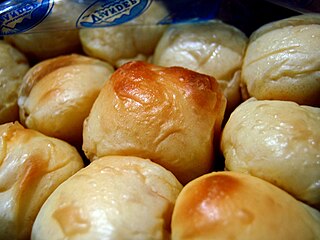
Pastel de Camiguín, or simply pastel, is a Filipino soft bun with yema (custard) filling originating from the province of Camiguin. The name is derived from Spanish pastel ("cake"). Pastel is an heirloom recipe originally conceived by Eleanor Popera Jose and the members of her family in Camiguin. She started to commercially sell it from 1990. It is primarily produced at the time of family's special occasions and gatherings.

Brazo de Mercedes is a traditional Filipino meringue roll with a custard filling typically dusted with powdered sugar. It is a type of pianono.
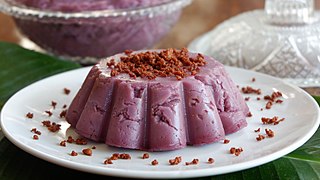
Ube halaya or halayang ube is a Philippine dessert made from boiled and mashed purple yam. Ube halaya is the main base in ube/purple yam flavored-pastries and ube ice cream. It can also be incorporated in other desserts such as halo-halo. It is also commonly anglicized as ube jam, or called by its original native name, nilupak na ube.

Macapuno or coconut sport is a naturally occurring coconut cultivar which has an abnormal development of the endosperm. The result of this abnormal development is a soft translucent jelly-like flesh that fills almost the entire central cavity of coconut seeds, with little to no coconut water.
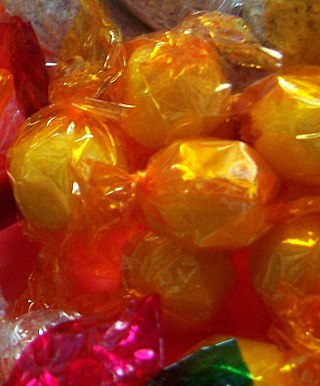
Yema is a sweet custard confectionery from the Philippines. It is made with egg yolks, milk, and sugar. The name yema is from Spanish for "egg yolk". Like other egg yolk-based Filipino desserts, it is believed that yema originated from early Spanish construction materials. During the Spanish colonization of the Philippines, egg whites mixed with quicklime and eggshells were used as a type of mortar to hold stone walls together. Filipinos reused the discarded egg yolks into various dishes. Among them is yema, which is possibly based on the Spanish pastry Yemas de Santa Teresa.

Ube cake is a traditional Filipino chiffon cake or sponge cake made with ube halaya. It is distinctively vividly purple in color, like most dishes made with ube in the Philippines.

Nilupak is a class of traditional Filipino delicacies made from mashed or pounded starchy foods mixed with coconut milk and sugar. They are molded into various shapes and traditionally served on banana leaves with toppings of grated young coconut (buko), various nuts, cheese, butter, or margarine. It is also known as nilusak, linusak, niyubak, linupak, or lubi-lubi, among many other names, in the various languages of the Philippines. It is also known as minukmok in Quezon.

Ube ice cream is a Filipino ice cream flavor prepared using ube as the main ingredient. This ice cream is often used in making the dessert halo-halo.



























